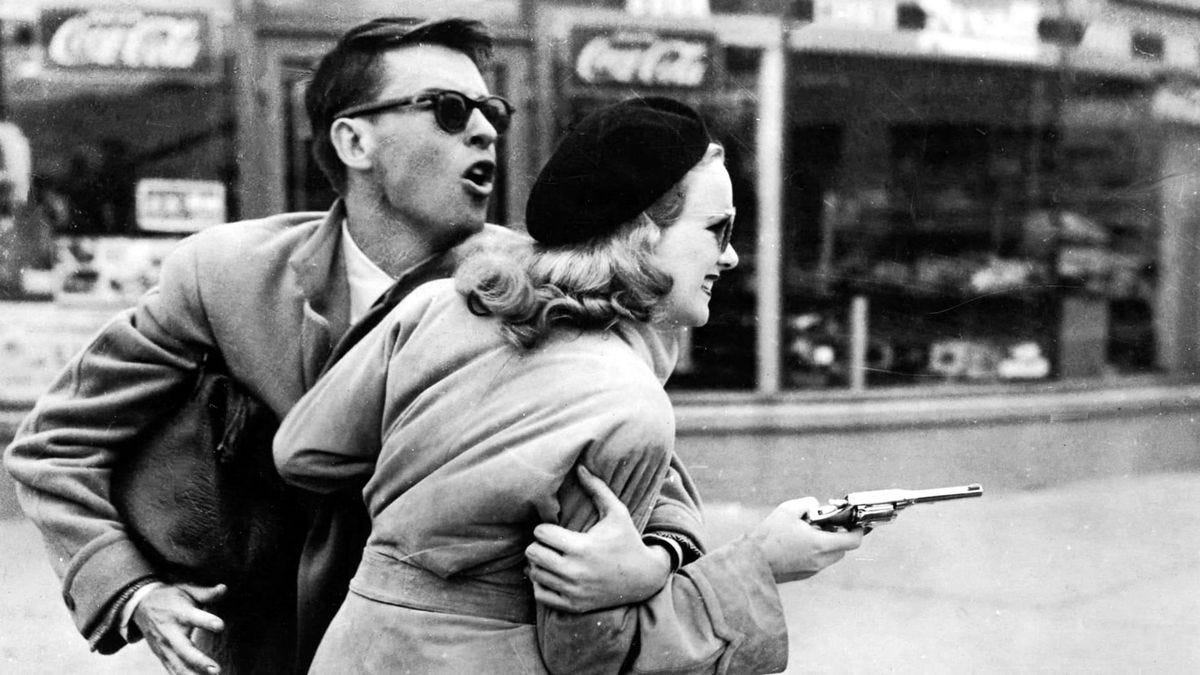I watched Joseph H. Lewis’ seminal film Gun Crazy for the first time on my couch in November of 2020, a crest during COVID lockdown’s thrall in which my isolation-induced depression peaked.1
Gun Crazy is a film with which most young cinephiles are aware, but it was never one that I felt the urge to put on, for no reason in particular, it just never rose to the top of the list. When I finally watched it during a depressive episode in which I was watching 2-3 movies a day (what else was there to do), I was underwhelmed; this is the movie that launched a thousand ships?
Then last week, I saw clips from the film during my rewatch of A Personal Journey with Martin Scorsese Through American Movies, in which the titular Martin Scorsese just talks about movies he loved as a child,2 and my pelvic floor moved.
I rushed to rewatch it and found it to be an entirely different movie than what I had seen in 2020.3 I now could see that Gun Crazy is a movie that reeks of gunpowder and cum, a movie that pushed the limits of what was allowed onscreen in its time with regard to depictions of sex, violence, and the intersection thereof.
Gun Crazy is a simple noir about the inherent human compulsions to kill and to fuck: two gun fetishists find each other and go on a crime spree. Bart Tare, played in his youth by Russ Tamblyn (credited as “Rusty”) has been obsessed with guns since childhood and is sent to reform school. After, he joins the army to teach marksmanship a few more years and then finally returns to his hometown as John Dall, the embodiment of effortlessly cool postwar New York faggotry.4
Bart reconnects with his buddies, one of whom seems to be the prototype for Sebastian Stan, though the kinks were not yet worked out, which leads to the achingly sincere exchange:
Sebastian Stan: How’s it feel to be an uncle to a couple a’ swell kids like that?
Bart [slow smile creeping across his face]: Pretty important…
One night, Bart & Buds go to the traveling circus5 he lays eyes on Laurie (Peggy Cummins) a sharpshooter with a stage and a dream, and very soon they marry primarily due to their their mutual fixation over firearms and their desire to fuck each other to death.
The story itself was nothing novel, but modernity seemed to have come to the crime melodrama, at last, as Bart and Laurie come to blows with the mundane, struggling to find a parking spot ahead of a heist—in their slim fit pea coats, textbook berets, and Ray-Ban Wayfarer sunglasses.
It was these gestures of authenticity that gave the film its novelty, to say nothing, of course, of Lewis’ arresting visual style: the film combines a Wellesian expressive formalism, rigorous and disciplined in its staging, framing, and composition; with a frenzied, feral documentary realism, some nine years before John Cassavetes’ Shadows was heralded as the beginning of the American independent film movement.6
The tension between the opposing visual styles gives the film an undeniable and propulsive momentum, heightened by the raw and animalistic performances of Dall and Cummins as they barrel toward inevitable ruin.
Cummins is particularly, let’s say, uninhibited. Her open mouth quivers in close-up as Laurie lies on the cheap motel bed, as Bart’s own mouth descends upon her from the top of the frame, as if sex will not be enough, as if she must literally devour him in order to satiate her lust.
But Laurie is at her most visibly aroused after a heist; Bart asks her if anyone is following and she turns back to look right at the camera, a devious gleam in her eyes, and says “it’s all right” with all the sexual force a film made in 1950 would allow.
Then, after they have decided to go straight, Laurie is seen prostrate in Bart’s lap as she begs him to do “one more job”—The Big One—a junkie in search of a fix, willing to debase her body to get it. Sex alone could no longer do the job; this girl needs to shoot!
Bart and Laurie know that the only way to survive unscathed after The Big One is to separate for at least several months, if not a couple years; they say their farewells and begin to drive in opposite directions. But they both stop and turn their massive American cars around, a balletic movement bringing our lovers back together as the music crescendos, and they reunite with a passionate kiss (they had last kissed approx. 17 seconds prior).
They decide to just do the stupid thing, consequences be damned, they simply cannot bear to spend a single moment apart—and what’s more romantic than that?
Famously, I watched all of the hit FX series Damages out of order at this time. I had files of the entire five season run and every episode was mislabeled. For 59 hours, I never questioned that something was amiss, I just assumed my brain rot was so advanced that I couldn’t follow the program. I now consider this one of the great achievements of my adult life.
Who will pay me to do the same? I am available for work.
I mean this metaphorically but maybe it was just a mislabeled file ijbol.
His character is straight in the film but I have eyes that can see.
You don’t really get troupes of itinerant carnies in the American cinema anymore: bring back troupes of itinerant carnies!
No disrespect to John: my hero, life coach, and guardian angel.







DAMAGES SHUFFLE WATCH MENTIONED